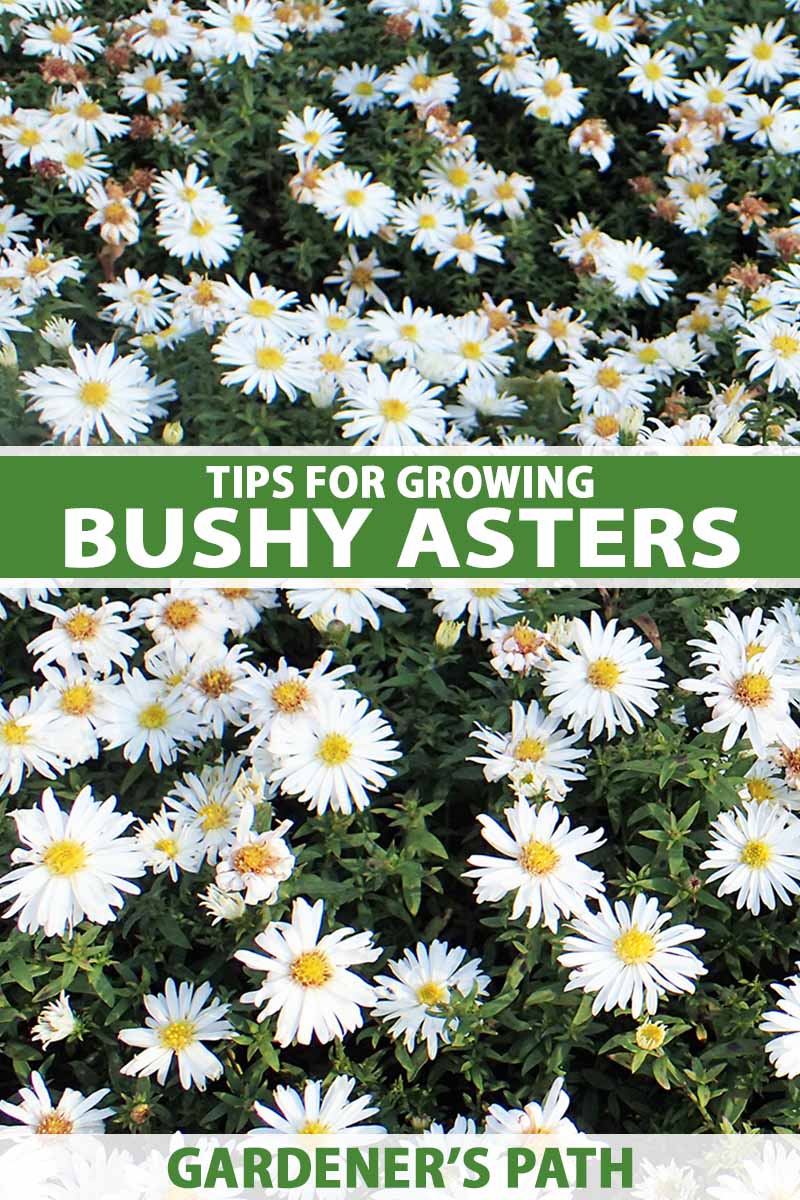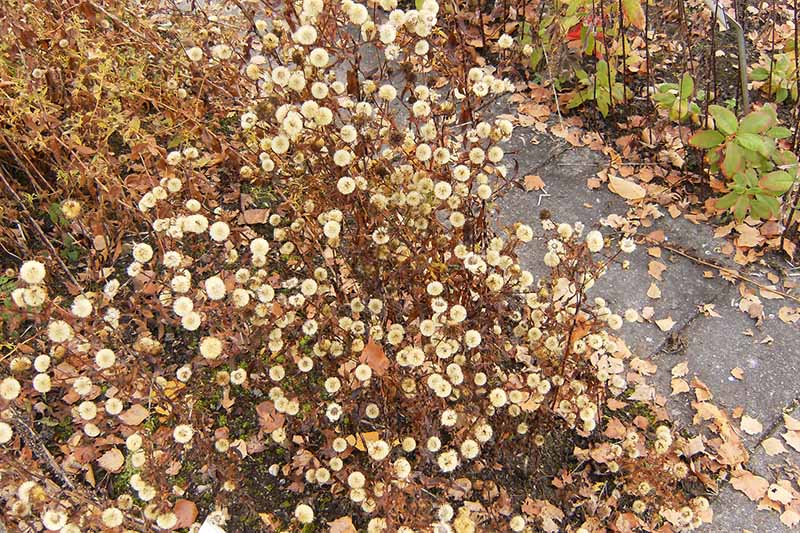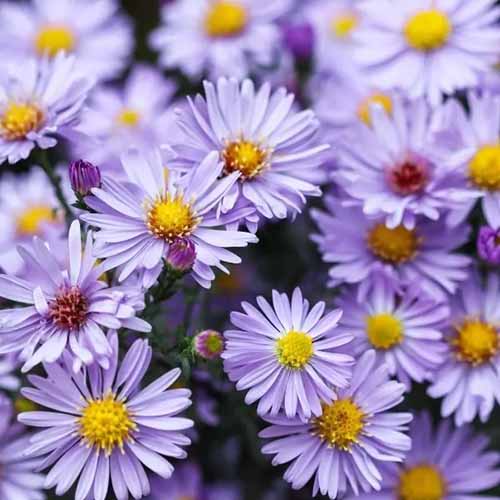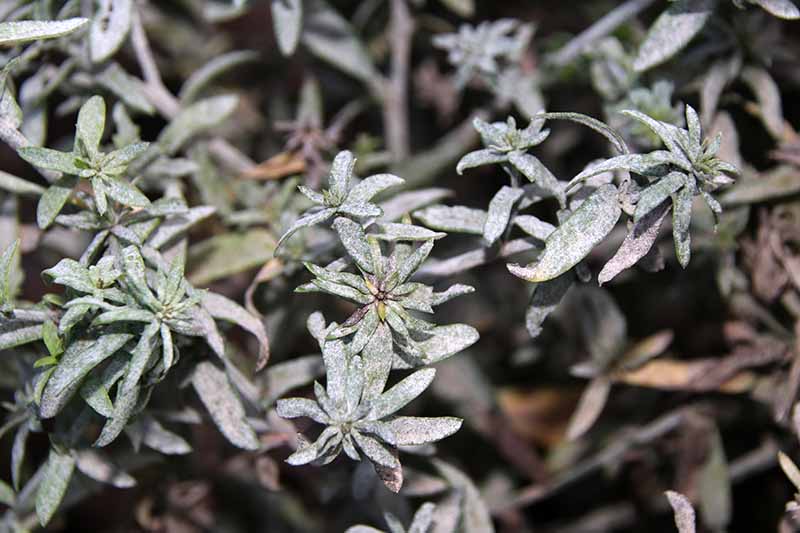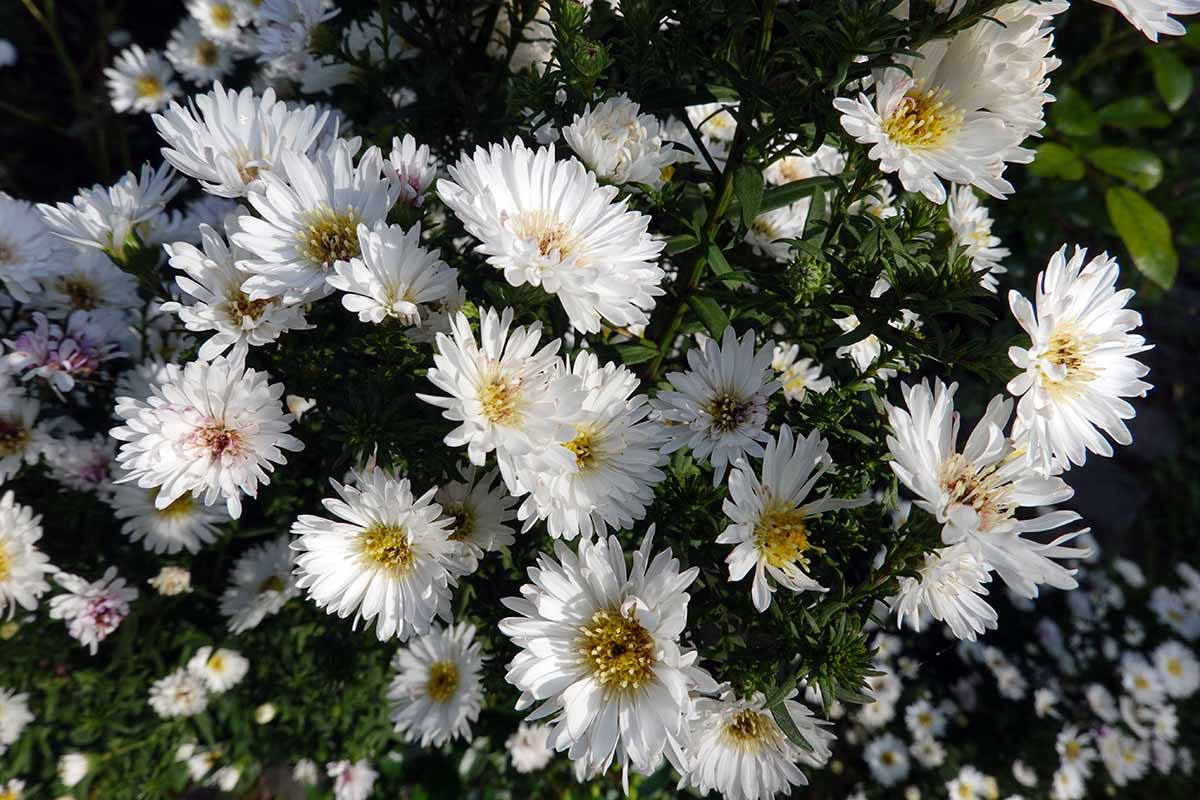And while many have a bushy growth habit, only one species, Symphyotrichum dumosum, formerly Aster dumosus, is commonly called the bushy aster. You may also know it by the names button, cushion, or long-stalked aster. We link to vendors to help you find relevant products. If you buy from one of our links, we may earn a commission. They are easy to spot in the late summer to early fall in forest clearings and along roads and streams, usually covered in native bees, beneficial insects, and butterflies. Although it’s suited to cultivation in USDA Hardiness Zones 4 to 8, you’re not likely to find the actual species S. dumosum plants for sale, but rather cultivated hybrids. In our guide to growing asters you’ll find an overview of these plants and their cultivation. Our present discussion focuses on understanding the bushy aster species, including its cultural requirements, cultivation, hybrids, and varieties. Here’s what’s in store: Let’s get acquainted with this species.
What Is a Bushy Aster?
The bushy aster species, S. dumosum, is explicitly classified as S. dumosum var. dumosum because multiple varieties have been identified, including:
S. dumosum var. gracilipesS. dumosum var. pergacileS. dumosum var. strictiorS. dumosum var. subulifolium
A variety has one or more slightly different traits but shares the overall characteristics of the species plant. In the case of the bushy aster, these varieties are sometimes considered “synonyms” that warrant further study. And while their distinctions may not directly impact home gardening, their status in the wild is of the utmost concern to environmentalists. For example, S. dumosum var. strictior is a possibly endangered “Wisconsin Special Concern Plant.” Another challenge to understanding the dumosum species is that these plants hybridize in the wild, crossing with other members of the Symphotrichum genus. An example is the rare S. dumosum x S. laterifolium, a natural hybrid with structural variations of the stalks and petals. The bushy aster has a “composite” flower consisting of petal-like rays around a central disk of florets. It measures less than one inch across. The rays may be white and faintly blue, lavender, or pink. They surround a yellow center that gradually deepens to reddish-brown. The plant has multiple stalks with lateral stems or “inflorescences” with a flower at the terminal end. Another name for the inflorescence of a compound flower is “anthodium,” a word you may come across as you explore the species. Plants mature to 12 to 36 inches tall and 12 to 18 inches wide. Cultivated hybrids offer desirable traits like more compact growth, brighter colors, and larger blooms. And, as you will learn in the Cultivars to Select section below, some have a broader spread of 24 inches wide.
Propagation
To grow plants, you’ll need to start with seeds, stem cuttings, or divisions of mature specimens. You can find complete instructions for starting plants in our guide to propagating asters. Here are the essentials of each propagation method:
From Seed
To start with seeds, purchase them or collect them from an existing plant. Note that if you collect seeds from hybrids, they may not grow true to the parent plant. You can start seeds indoors in late winter to get a jump on the growing season. Alternatively, you can start seeds outdoors after the danger of frost has passed. Sow the seeds shallowly, barely covering them with an eighth of an inch of soil.
From Cuttings
When plants are underway in spring and early summer, you can use clean shears to cut a length of five or six inches from the tip of a soft growing stem. After removing the leaves from the bottom four inches, place the bare stem in four inches of water. Change the water daily to maintain a healthy environment for root formation. When you see roots forming, you can transplant into the garden or a container. Or, moisten the bare stem, dip it into powdered rooting hormone, and plant it in a small pot filled with potting medium. When you see new leaves starting to form, you’ll know the stem has rooted.
From Seedlings/Transplanting
Before you set your nursery starts or seedlings out into the garden, you’ll need to harden them off first. Do this by placing them outdoors in a protected location for a few hours each day, gradually increasing the time over the course of a week. The key to success with transplanting seedlings, rooted stem cuttings, and nursery plants is to note how deeply they sit in their containers. Place them at the same depth in garden soil for a seamless transition, and tamp the soil around them.
How to Grow
S. dumosum plants prefer a full sun location but can tolerate part shade. The ideal soil is organically-rich loam, but average quality is also suitable, provided it drains well and has a mildly acidic pH of 5.1 to 6.8. After the last average frost date for your region has passed, work the garden soil to a depth of eight to 10 inches. It should be crumbly and free of rocks and debris. Allow 12 to 18 inches between species plants and up to 24 inches for some hybrid cultivars. This spacing ensures adequate airflow and inhibits fungal growth. Apply a slow-release, all-purpose granular fertilizer at planting time, and water gently but thoroughly. Keep the fertilizer away from the stems, as it may burn tender plant tissue. Provide an inch of water per week, rain included. After the first year, plants are well-established and require supplemental water only in overly dry and/or hot weather.
Growing Tips
These plants perform well, especially with excellent care from the start. Give them every opportunity to succeed by remembering to:
Sow the seeds shallowly.Place transplants at the same depth they were in their containers.Space to accommodate mature dimensions, provide ample airflow, and inhibit disease.Apply fertilizer at planting time to support healthy growth.
Pruning and Maintenance
Whether you are growing wild varieties or hybrids, your plants will likely become a bit leggy. You can prune them early in the summer for a more compact form, but you may adversely affect flower production if you prune too late. Learn more about how to prune asters in our guide. Instead, you can stake plants with twine and bamboo or metal stakes to prevent the stalks from flopping over and risking damage. If a stalk breaks, make a clean slice with clean pruning shears to sever it an inch or two above the crown. The crown is where stalks and roots come together. Ragged “wounds” make flora vulnerable to pests and disease. Additional maintenance includes cutting all stalks to the ground and discarding them at season’s end to avoid harboring insects that may overwinter in the debris. However, if you like the look of the fleecy seedheads as winter approaches, you can wait until late winter to accomplish this task. In three to four years, you may find that your plants are crowded and/or producing fewer flowers. If so, divide your asters and transplant them as desired. Dividing not only opens up airspace to inhibit fungal disease; it also rejuvenates flora, improving health and flower production. Continue this practice as needed, and your plants will reward you with blooms well into the future. And finally, every spring, when the new shoots appear, fertilize as we did above for a season of vigorous growth.
Cultivars to Select
It may be challenging to find actual species like those in the wild when shopping for plants. What you may discover, especially if you use UK sources, are dumosum hybrids developed by crossing the bushy species, S. dumosum, with the New York aster, S. novi-beglii. Many of these are listed for sale as New York asters, followed by a cultivar name. For example, S. novi-beglii ‘Snowsprite.’ Others are available under the old classification, A. dumosus, and the current classification, S. dumosum. Here are three hybrids for your consideration.
Peter Harrison
Pretty in pink, perennial S. novi-beglii ‘Peter Harrison’ is a dwarf cultivar suited to Zones 4 to 8. It is not to be confused with a different species by the same name, the silver carpet aka common sand aster, Lessingia filaginifolia, a ground cover species native to California.
Sapphire
Lavender-blue S. dumosum ‘Sapphire’ is a dwarf variety suited to Zones 4 to 11. It reaches a mature height of only 15 to 18 inches and spreads to 24 inches for a low-profile expanse of color that is sure to be noticed. ‘Sapphire’ ‘Sapphire’ plants are available from Nature Hills Nursery in #1 containers.
Silver Carpet
Dwarf cultivar S. dumosum ‘Silver Carpet’, aka S. dumosum ‘Silberteppich’ has white blossoms with a subtle hint of lavender. Plants mature to 12 to 18 inches tall and, like the ‘Peter Harrison’ cultivar, are spaced at 12 inches for a demure display.
Managing Pests and Disease
Asters may be plagued by pests and disease, especially in prolonged dry or wet weather. Common pests to be on the lookout for include:
AphidsChrysanthemum Lace BugsCucumber BeetlesMealybugsLeaf MinersNematodesSlugs and SnailsTarsenoid Mites
Pests are troublesome enough, but did you know that they can carry plant diseases? One way to address them is to fill your yard with nectar-rich plants that attract beneficial insects, a valuable biological component of pest management. Some diseases to be aware of include:
Aster YellowsLeaf SpotPowdery MildewRustStem CankerWhite Smut
Please consult our guide to common aster diseases and pests for more information. (coming soon!)
Best Uses
The wild, species bushy aster is suited to open spaces with room to allow it to naturalize informally, without garden borders to dictate its behavior. If you have a clearing in a wooded area of your landscape, a stream bank, or a perimeter fence, you may want to consider S. dumusom. In addition to mass plantings that offer expansive drifts of tiny blooms that pollinators and songbirds love, you may want to incorporate bushy asters into a butterfly garden design scheme or add several to a mixed native wildflower collection. Early in the growing season, the lush foliage forms a green backdrop that makes a good windbreak should you require one. Today’s dwarf hybrid dumusom cultivars are suited to beds, borders, and container gardening, where their smaller size makes them good mixed arrangement pot mates and stand-alone specimens. Our guide to aster companions suggests a variety of flora with similar cultural requirements to asters, like goldenrod and joe-pye weed. As a floral designer, I look to the aster as a “filler” flower for late-season arrangements. It affords a backdrop and physical support for the other two elements of a design, the “thrillers” that steal the show and the “spillers” that give a piece motion. I like to think of them as filler in the garden, too, bridging the gap between summer and fall. However, there are better-behaved hybrid cultivars to consider for those who don’t care for the species plant. Regardless of which you choose, perennial aster blossoms bring much-needed color to waning late-season gardens. They also make attractive filler flowers in vase arrangements, lasting for up to two weeks. What do you think of this type of aster? Are you ready to add it to your garden planner for further exploration? Let us know in the comments section below! Let the bushy aster be a bridge from summer to fall in your landscape, and watch it make many hungry pollinators very happy! And for more information about growing different types of asters in your landscape, you might enjoy these guides next:
Grow New England Aster for Sensational Summer and Fall ColorHow to Grow and Care for Calico Aster in the Late Summer to Fall GardenHow to Grow and Care for Sky Blue Aster
